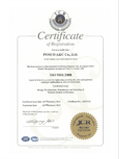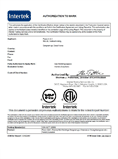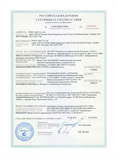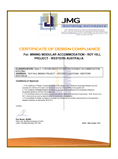System
POSCO A&C Modular System “MUTO” applies industrialized construction methods by using standardized modules
fabricated within the factory and assembled on site to reduce construction period up to 50%. This system enables
up to 80% reuse of building structure when buildings are dismantled and reconstructed. POSCO A&C Modular
System method based on cheonan modular factory certified in Russia, Australia, and Canada suggests a new
paradigm in architecture by cost reduction through uniform quality and mass porduction.
![]()
Sustainable, Eco-friendly, Future Architecture
System
The combination of POSCO’s high-quality steel materials and
POSCO A&C’s steel structure technology completes the best residential function. Factory production and civil engineering
work on site are done at the same time, which reduce
construction period. Moreover, structure and construction
methods are researched and developed for optimized transportation.
Certification Status
-

ISO 9001
Quality Management
System -

Canada CSA
Factory Quality
Systems -

Russia GOST-R
-

Australia BCA
Architectural Paradigm Change
- Labor intensive/Technology intensive
- Onsite centered/Factory centered
- Wet construction method/Dry construction method
Modular Reuse or Recycle Concept
Factory -> Release -> Assembly -> New construction site -> Disassembly -> Module reuse -> Removing and reconstruction site OR Factory -> Release -> Assembly -> New construction site -> Disassembly -> Material recycling -> Removing and reconstruction site
Speed
Reduce the construction period by simultaneous
progress in a site and a factory
- Simultaneous design, factory production of modules, and
civil engineering work. - Possibly made in an all-weather factory.
- Shortened on-site construction minimizes resident’s complaints.
Up to 80% of architectural processes can be made in a
factory, such as structural facilities, electricity, fire preven-
tion, communications, interior/exterior finishes, and more.
Comparison of construction periods by construction
methods
RC frame (108 days),Steel frame (101 days),Modular frame(50 days) - Compared to the existing RC and steel frame,innovative rate of a reduction in construction periods 50%
Smart
Build up smart systems based on standardization
and mass production
- Standardization of materials to be applied
minimizes wastes. - Mass production saves the contruction cost.
- Minimized building material disposal reduces the costs.
Shortning period of on-site construction can reduce
about 5% of the temporary work costs and about 10%
of overhead costs.
Comparison of recycling by construction methods
RC frame (108 days),Steel frame (101 days),Modular frame (50 days) - Reused rate during removal and reconstructionafter dissembling 82.3%
Eco-friendly
Realize the sustainable architecture by reinstallation
and reconstruction with recycled modules.
- The reuse and recycling of up to 80% of disassembled
steel modules. - The use of eco-friendly steels with higher recycling rates than
wooden and concrete. - The use of high strength steels with more than 100-year high
durability reduces housing life span costs.
MUTO modular building are equipped with excellent usabil-
ity that can respond to user’s needs by changing usage,
expansion, renovation, modular recombination, and more.
Comparison of construction waste disposal costs by
construction methods
Cost reduction rate compared to the existing methods - 25%
Earthquake·Wind Resistance
- Applied structural steels with excellent earthquake resistance and weldabillty.
- Met seismic performance specifically requested by customers
Fire Resistance
Passed not only Korean standards (60 min.) but also the test of module (90 min.) for Russian Standard (GOST-R)
Insulation·Air Tightness
Minimized error ranges due to factory preduction. Insulation
and air tightness are better than standards for the apartment
by 8.7% (energy saving).
| Division | Standards for the Apartment |
MUTO | Energy Efficiency |
|---|---|---|---|
| Roof | 0.150 | 0.1451 | |
| Outer Wall of Unit |
0.240 | 0.2342 | |
| Floor of the Lowest Unit |
0.230 | 0.1782 | |
| Floor between Units | 0.340 | 0.3372 | |
| Glass on Outer Wall of a Unit |
2.1 | 1.798 |
Sound Insulation·Floor Vibration
Applied wet floor for dry construction method to meet
the apartment Act in Korea ; The Impact sound levels of lightweight and heavy floors are 58dB and 50dB.
Mobility (Reconstruction·Reuse)
Reusable without demolition and new construction
Maximize profits to investment by reusing 80 -90% of
factory-made parts.
Comparison
| Division | RC Frame | Modular System |
Remark |
|---|---|---|---|
| Reconstruction and Reuse |
0% | 80~90% | Factory-made parts |
| Demolition & Reconstruction Waste |
100% | 28% | Modular joints, foundation, civil engineering, some exteriors |
Green
Total energy reduction rate : 33.42% (Grade 2)
- Building Energy Efficiency Rating Certification Regulations
No. 2009-1306 announced by the Ministry of Land,
Transport and Maritime Affairs
(revised on Dec. 31, 2009, Apr. 5, 2010, and Sep.,2013)
| Grade | Energy reduction rate |
|---|---|
| Grade 1 | 40% or above |
| Grade 2 | Less than 30% ~ 40% |
| Grade 3 | Less than 20% ~ 30% |
| Grade 4 | Less than 10% ~ 20% |
| Grade 5 | Less than 0% ~ 10% |
Construction
Method
Unit
![]()
- Factory production(=reusable rate)
: Max. 80% - Time saving rate to RC : 50%
Panelizing
![]()
- Factory production(=reusable rate)
: Max. 50% - Time saving rate to RC : 30%
In-fill
![]()
- Factory production(=reusable rate)
: Max. 80% - Time saving rate to RC : 50%











































